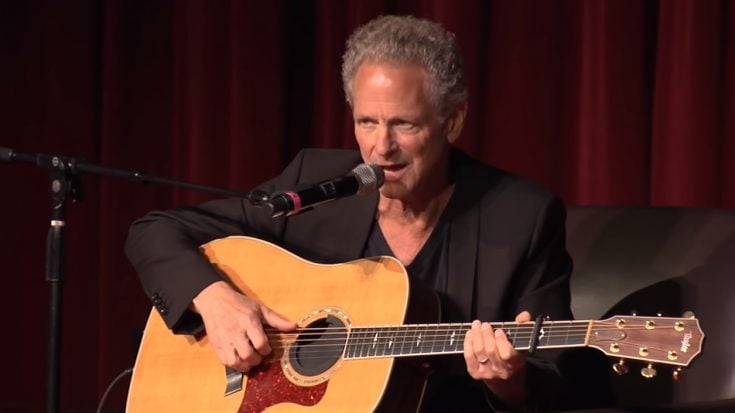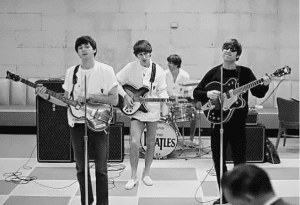Lindsey Buckingham Breaks Down His 10 Best Guitar Works

Lindsey Buckingham live at USC - TheLeapTV / Youtube
Over the past few years, Lindsey Buckingham’s life has been marked by significant upheavals: he got fired from the legendary Fleetwood Mac in 2018; he underwent emergency open heart surgery in 2019; and Kristen Messner, his wife of 21 years, filed for divorce in 2021.
Heartaches such as these once more inspired the accomplished rock veteran when he released his 2021 self-titled album.
This solo effort rummages around into quieter moments. It explores the timeless relationship themes that have consistently elevated his work, as it showcases Buckingham’s unmistakable California pop-rock style and intricate fingerpicking technique.
In a 2021 interview with Entertainment Weekly, a few days before he released his seventh record, the guitarist took a stroll down memory lane and revisited the stories behind his most memorable songs and iconic guitar riffs.
1. “I’m So Afraid”, Fleetwood Mac (1975)
“I’m So Afraid” is composed by Lindsey for Fleetwood Mac’s self-titled tenth album, serving as its closing track. Originally, this song had been intended for a second record of the duo pre-Fleetwood Mac project called Buckingham Nicks, an effort that regrettably never came to fruition.
Similar to all other songs co-authored by Buckingham and Nicks on the Fleetwood Mac album, “I’m So Afraid” was written before the pair joined Fleetwood Mac. “We’d been in LA only for like a year and a half,” the guitarist explained. “Things happened pretty fast. The album came out, and it didn’t really connect and we were working material for a second album”.
“I’m So Afraid” was released as the B-side to the song “Over My Head”. It departed from Fleetwood Mac’s typical style at the time, particularly when compared to their work following the Peter Green era, leaning toward a hard rock sound.
However, it rapidly became a regular feature in their live performances, allowing Buckingham’s exceptional guitar prowess to shine. Although the studio version is in G natural minor, live renditions are often transposed down to F natural minor.
2. “Never Going Back Again”, Rumours (1977)
The second track on this list is one of Lindsey’s favorites in their classic record Rumours, released in 1977. “Never Going Back Again” is one of several on Rumours that the guitarist composed in the aftermath of his breakup with fellow Fleetwood Mac member Stevie Nicks.
Buckingham recollects that he penned it toward the end of the album’s creation, during a period when he had entered into a new relationship as a rebound from his prior one. Despite its sweetness, Buckingham doesn’t consider the lyrics to delve deeply but rather sees them as an expression of the desire to avoid repeating past mistakes.
“Lyrically, it was a bit naive, because it was obviously about Stevie,” he shared. “By the time I wrote that, we’d had a few ups and downs, and she’d moved away from me more than once and come back. It was about Stevie, and it was also about meeting somebody else. It seemed to reaffirm that there was life after that, and yet, you create this illusion of ‘I was down once or twice, but I’m never going back to that again.’ Which is not really the way it works.”
In “Never Going Back Again”, Buckingham accompanies himself on acoustic guitar using a Travis picking technique. To achieve the desired sound, producer Ken Caillat suggested restringing Buckingham’s acoustic guitar every 20 minutes, despite the labor-intensive nature of the task. The song is composed in a 4/4 time signature with a moderate tempo of 88 beats per minute, situated in the key of F sharp major.
3. “The Chain”, Rumours (1977)
Another Rumours track, but this time, it’s a collaborative effort of the classic lineup of Buckingham, Nicks, Christine McVie, Mick Fleetwood, and John McVie.
“The thing about ‘The Chain’ is, yes, it’s a signature piece of ours,” he said. “But it’s also the spirit of the song and the content lyrically is very much in keeping with the legacy we built over a long period of time of always being able to rise above the difficulties in order to fulfill a greater destiny, so there was always a chain.”
In the wake of the resounding critical and commercial triumph of Rumours, “The Chain” has become a staple of Fleetwood Mac’s live performances, often serving as the opening number. It took the lead spot on The Dance, a live concert CD/DVD release from 1997, as well as featuring prominently in several of the band’s greatest hits compilations.
The final segment of the song, marked by a distinctive bass progression, was crafted by John McVie and Fleetwood. Nicks’ lyrics alluded to her breakup with Buckingham, a recurring theme in Rumours. Additional elements were integrated from an earlier project of Christine’s called “Keep Me There”, which retained the chord progression while shedding the blues-style motif. To finalize the song, Buckingham repurposed the intro from a prior duet with Nicks titled “Lola (My Love)”, originally released on their self-titled 1973 album.
4. “Tusk”, Tusk (1979)
Tusk is the 12th album of Fleetwood Mac and it was the brainchild of Buckingham as he was adamant in experimenting with a record that’s very different from the best-selling Rumours. The distinctive melody of the title track of this double LP was borne from a rehearsal riff that Buckingham plays for sound-checks.
“I was very interested in confounding external expectations, not bowing to those expectations and starting to paint ourselves into a corner creatively by continuing to try to make Rumours 2 or 3,” the guitarist shared. “For that reason, not just the song ‘Tusk,’ but the album Tusk is probably my favorite album. Not necessarily for the music, but for why we did it—and it set me off on this alternative path that was a tightrope to walk between the big machine of Fleetwood Mac and the small machine of solo work that followed.”
In addition to the traditional drum kit, the band ventured into experimenting with unconventional found sounds for “Tusk”, including a Kleenex box and lamb chops.
At the behest of Fleetwood, the band enlisted the University of Southern California’s Trojan Marching Band to participate in the recording of the single. The concept of incorporating a brass band into “Tusk” came to Fleetwood while he was vacationing in Barfleur, where he was awakened by a local brass band performing outside.
5. “Trouble”, Law and Order (1981)
“Trouble” is Lindsey’s first solo release, coming in 1981 as part of his debut solo album, Law and Order. This single signified the guitarist’s initial breakthrough as a solo artist, achieving a peak position of number nine in the United States and reaching number 31 in the UK, where it maintained its presence on the charts for seven weeks.
For this song, Buckingham opted for a distinct approach, aiming to infuse it with a more “live feel”. To achieve this goal, he enlisted the talents of his Fleetwood Mac bandmate, Mick Fleetwood, to handle the drums. However, Buckingham found none of the takes entirely satisfactory from start to finish, prompting the use of a taped drum track loop, lasting approximately four seconds, throughout the song.
Relating to his experience of exploring more of his “esoteric side” and his old band’s decision to steer away from the experimental sounds of Tusk, Lindsey explained, “In Fleetwood Mac, [I was] called upon to do more the rock side of things, but not necessarily the mid-tempo pretty stuff. I had that in me, and “Trouble” was a good representation of that. I was covering a broader landscape musically.”
Buckingham also contributed half-speed guitars for the choruses and a guitar solo with a Spanish influence, a segment of which he held in high regard. In terms of vocals, Buckingham incorporated falsetto into some portions of the song.
6. “Holiday Road”, National Lampoon’s Vacation OST (1983)
“I’d never written a song for a movie and I didn’t really have a set of reference points for it and wasn’t sure if I even had the skillset for it,” Buckingham explained how he approached this track from the soundtrack of the 1983 film National Lampoon’s Vacation.
After Fleetwood Mac’s 1982 album Mirage hit the shelves, Lindsey received a proposition from actor/director Harold Ramis. Ramis asked him to compose two songs for his second movie as a director, which happened to be National Lampoon’s Vacation. Initially, Buckingham was hesitant because he didn’t consider soundtrack work to be in line with his usual artistic pursuits. However, he eventually relented and agreed to fulfill Ramis’ request.
Buckingham recorded “Holiday Road” without having seen the entire film, but he surmised that the movie needed to have an uplifting and somewhat humorous vibe based on his understanding of the project.
The song, however, easily became one of the guitarist’s best-known solo works. “Holiday Road” was also used in the film’s sequels National Lampoon’s European Vacation (1985), Vegas Vacation (1997), and Vacation (2015).
7. “Big Love”, Tango in the Night (1987)
In 1985, Buckingham started compiling material for his third solo album, amassing a collection of approximately 50 songs during these sessions. Among this extensive catalog of songs was “Big Love”, which Buckingham originally intended to include in his solo project.
However, his band Fleetwood Mac was also in the midst of creating a new album. Hence, Buckingham set aside his solo ambitions and offered “Big Love” to the band instead.
“‘Big Love’ started off as a completely different song,” The guitarist said. “The track was still based around that finger-picking part, but it wasn’t focused in such a clear-cut and singular way…By the time we got back together in ’97 to do The Dance album, I had [emphasized] my fingerstyle, which is very orchestral and has the potential to be a complete statement on its own without any other instruments. I’ve made my fingers bleed on numerous occasions.”
The band made minimal alterations to Buckingham’s original demo when preparing it for the final release. Notably, Buckingham handled the oh-ah vocals himself by sampling his own voice, a detail that raised questions among some listeners who wondered if it featured Stevie Nicks alongside him. In response to this, Buckingham remarked, “It was odd that so many people wondered if it was Stevie on there with me.”
8. “Underground”, Gift of Screws (2008)
Underground is the ninth track from Buckingham’s fifth solo album Gift of Screws, released in 2008. This song was borne out of his frustrations with his record label, Reprise Records.
“They never really knew what to do with my solo stuff,” he explained. “Fleetwood Mac was the priority…By the time I got to doing Gift of Screws, it felt like their interest in me as a solo artist was on the wane, and that’s really what that song is about. The idea was I guess I’ll just keep going underground.”
After completing the album and presenting it to Reprise, Buckingham was advised to hold back certain tracks for a future Fleetwood Mac album. Following this, the guitarist contributed several of these songs to the 2003 album Say You Will. Furthermore, these tracks also found their way into his next solo endeavor, Under the Skin, which was released in 2006.
The songs for Gift of Screws were recorded spanning the years 1995 to 2000, with some of them receiving live performances and recordings by Fleetwood Mac during their 1997 album and tour for The Dance. Additionally, these tracks include contributions from fellow band members Mick Fleetwood and John McVie.
9. “Love is Here to Stay”, Lindsey Buckingham Christine McVie (2017)
In January 2017, Lindsey and Christine McVie made a joint announcement about a collaborative studio album called Lindsey Buckingham Christine McVie, which also includes the participation of Mick Fleetwood and John McVie. This will be one of the last studio projects Christine will work on before she dies of a stroke in November 2022
Initially, the album was intended to be a full Fleetwood Mac project. However, Stevie opted not to take part, as she preferred embarking on a solo tour with the Pretenders. Lindsey Buckingham/Christine McVie, which was officially released on June 9, 2017, was a chance event.
“Christine sent me maybe three songs that she had very rough, and I worked on them in my studio,” Buckingham recalled. “I got a chance to craft them in a way she hadn’t foreseen. Then I said, ‘Look, I’ve got tracks that I have worked on, rough melodies without lyrics. Why don’t I give those to you and see what you can make out of those?’ And she took some of those and made them her own.”
“Love is Here to Stay” had been a musical idea Buckingham had been toying with for some time in his home studio. “What had changed was I had got married and had kids and had a whole new set of things to write about,” he added.
10. “On the Wrong Side”, Lindsey Buckingham (2021)
“I realized that I was, subconsciously at first, wanting to make it more of a pop album than what I had done before,” Buckingham said of his 2021 album. “You can make connections between “On the Wrong Side” and “Go Your Own Way” in terms of tone, vocals, and guitar solos. But working with the band is a more conscious, verbalized process. When I’m in the studio by myself, it’s like painting.
“On the Wrong Side” draws its musical and lyrical inspiration from Buckingham’s former band, Fleetwood Mac, from which he departed in 2018. The guitarist sings about the extensive and eventful history between Buckingham and the band, as well as the highs and lows experienced while on tour.
Lindsey likened going solo and working in the studio to a painting, where the “touches” of “On the Wrong Side” revealed themselves as he went along.
“You don’t have to have as clear a notion of what the song is. You have to know your melody and structure before you present it to another group of people, but if you go in with a general idea, things will reveal themselves incrementally to you” Buckingham concluded.





















